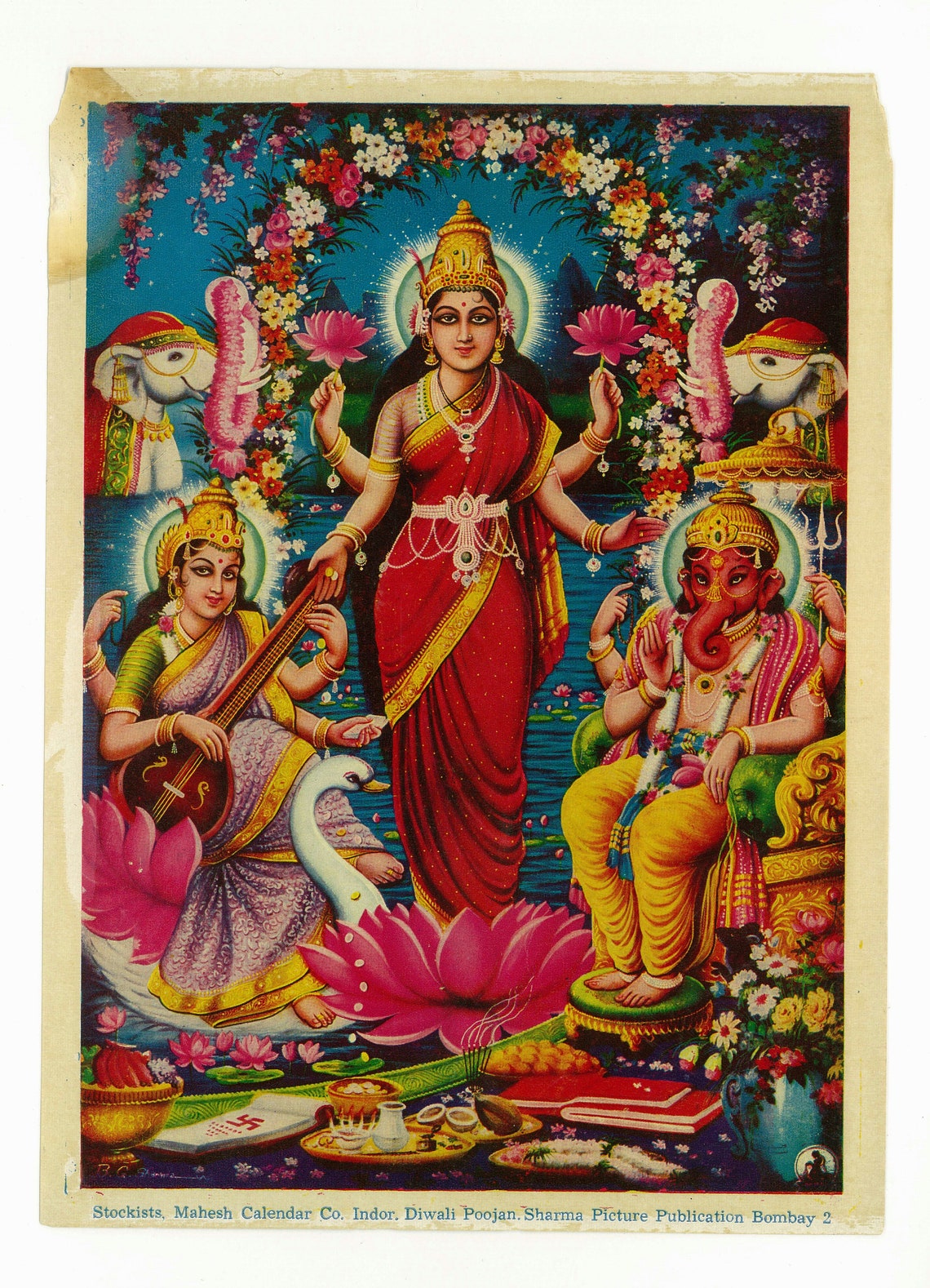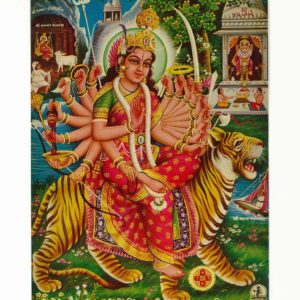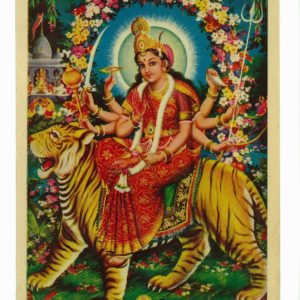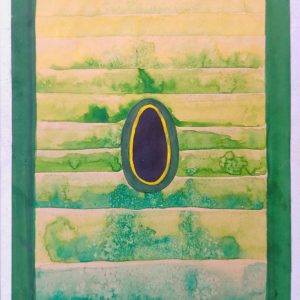This is an old stock unused print. My guess about its age is more than 40 years. The colors have a vibrance which new digital inks cannot get (partly because of new anti pollution laws). Unused new old stock isna rarity in vintage prints. There are three more prints from the same set also available. please don’t hesitate to press the chat button and enquire.
—
This piece has three favorite gods. At the center is Lakshmi Ji the goddess of material wealth. Saraswati Ji on the left is the goddess of wisdom. The elephant headed Ganesh Ji helps in overcoming hurdles, hence gives stability. It is not a coincidence that these three are connected to the trinity of hinduism, Brahma, Vishnu and Mahesh. Saraswati is related to Brahma, Lakshmi to Vishnu and Ganesh is the son of Mahesh or Shiv. These three together have a very wholesome energy. While Lakshmi alone is fickle, having the wisdom of Saraswati and the calm patience of Ganesha lets one retain and increase one’s wealth.
Saraswati ji is shown with a rosary in one hand and a set of palm leaf documents in another. The rosary beads shows her spiritual inclination, mantra chanting and so on. The palm leaves were used as books to write on in ancient india, and this denotes her affinity to jnana or knowledge. With rest of her hands she is playing her veena. The imparting of knowledge in ancient india was a oral tradition. Vedas are even now taught orally in the traditional gurukuls because on top of the pronounciation even the intonation should be perfect. This was often accompanied by a veena. Saraswati devi is also the ruling deity of the vishudha chakra. She rules the spoken word and vocal singing, so music. Hee original veena was called kachhapi veena, because the resonator was like a tortoise (kachhapi) shell. She is seen sitting on her ride the swan or the hamsa. Hamsa is considered a symbol of moksha, transcendence and spiritual purity. This is also the reason she is shown as wearing white clothes.
Ganeshi ji is shown with a red head, a different color from the rest of the body. He is the ruler of the muladhara chakra, which ia denoted by the color red. Muladhar chakra is the very foundation on which all other chakras rest. Without a strong and stable foundation no building can stand for long. He is the one which helps to retain the wealth. His right hand is in the abhaya mudra, assuring the devotee, ‘don’t be afraid’.
He also a rosary in one hand and a trishul or a trident. A trident is rich in symbolism. It means creation, preservation and destruction. More than the symbolism it was the trident with which Ganesha’s original head was severed by Shiva. In his hands it denotes the tearing down of old ways to create new ones.
Coming back to Lakshmi ji, she is shown inside a lotus. Lotus or padma is considered the epitome of purity. Even though it might well be rooted in muddy waters, it transcends up through the water and blossoms in the air. The lotus came out of the navel of Vishnu and symbolizes the material world. Lakshmiji is considered the nector which gives this material creation its flavor and beauty. She is shown standing because this picture is primarily about her. The others are there for her support. Two of her hands hold lotuses. One hand with the coins emerging is actually the varda or the wish giving mudra. With Lakshmiji coins adds to the meaning of the mudra as she is the one who accepts the wish for wealth.
The things kept in front of lakshmi ji are all connected in some ways to her. The red wide book is the traditional account keeping book, also calles the bahi. It is binded with the red colored cloth, favourite with lakshmiji. Deepawali or diwali is the start of the financial year in ancient india. On this day new red binded account books were started for the account keeping from then onwards. Burning incense, burning lamps, fruits, sweets, coconuts broken and unbroken all these are uses for lakshmi worship.
There is one more aspect of Lakshmiji I want to share which is not commonly known. She emerged when the ksheer sagar or the milky ocean was churned by both suras and asuras. Usually translated as devas and rakshas or gods and demons. The fact that she emerged from the deep waters is the first evidence. Her avatar of Sita devi who is the campanion to Vishnu avatar was also found from beneath the earth, when her dad’s plough got stuck at box inside the earth. This is evidence number two. She is considered to have three fathers. The first one is Varun, the king of the seas, who gives its wealth to anyone who seeks. The second is the asura Puloman, and as his daughter she is known as Paulomi. She is also called Patala nivasini as most wealth is sourced from underground, gold, gems, food crops and so on. If Bhrigus is the father of fortune, Lakshmi is the fortune, so she is also called Bhargavi as his symbolic daughter. Bhrigu’s other famous offspring is Shukra or venus the asura planet responsible for wealth.
In short Goddess Lakshmi is an asura. Suras and asuras were just very different beings originally. Gradually in some parts of the world suras became gods while asuras became demons. Some people still worship asuras like Ahura Mazda. Even today when the asura name has become derogatory in some parts, everyone still craves for Lakshmi. She is the one thing which binds everyone in this polarized world.
….
The size of this print is 23 cm by 16.5 cm. The price is inclusive of shipping within India. On the left top corner there is a small watermark. It can be seen in this picture as well. That mark is present in all the copies. It is visible mostly on the white margin and hardly noticeable on the printed area. More than 50 copies of this print has been sold








Reviews
There are no reviews yet.